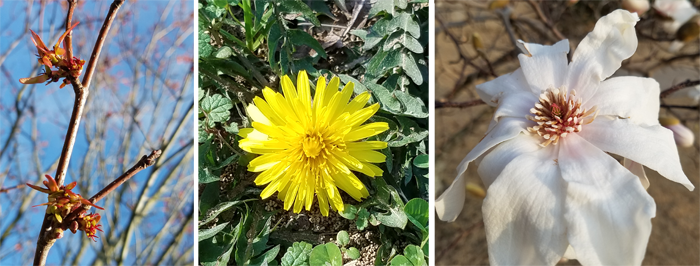
Spring Time in the Bee Yard
It's another early spring in Central Arkansas. Plants are already blooming, and our honey bees are active. How does this weather affect our bees? In general, an early spring benefit bees by increasing the food (pollen and nectar) available to them. Increased nutrient availability will help jump start brood production in the hives, and our colonies are off to great start! What could go wrong?

Left to right: Red maple doesn't produce a showy blossom, but bees recognize these flowers as important sources
of pollen and nectar at the beginning of the season. The common dandelion may be despised as a weed by some homeowners, but it's also an important early bloom
for bees to visit. The large blooms of a star magnolia may attract many species of pollinating insects, and its showy presence is a sure
sign that spring is in the air.
When bees begin building up their populations early, look for swarms to begin happening too. Honey bees are protandrous -- they produce drone bees well in advance of new queens. This is to ensure that when new queens emerge and are ready to mate, they will have no shortage of mature drones available to them. Our swarm season pretty much coincides with our nectar flow. The bees know that if they move out and start a new colony in a hollow tree, they will have to build all new combs and fill them with honey before next winter. They take advantage of the spring nectar abundance to build fresh combs, increase their numbers and gather in as much surplus honey as they can before summer arrives. Be sure that your bees have sufficient room for both brood and honey. If they hives begin to get crowded, the queen will want to initiate swarming preparations.
If you see swarm cells in your hives in the next few weeks, consider making some early splits. This will help them to overcome the swarm instinct, and you can have two colonies building up instead of allowing half of a good colony to take to the wing.
Another consequence of a mild winter such as this one is starvation. We know that our bees consume their stored honey in the winter to give them energy to generate heat. It may seem counterintuitive, but the bees actually consume more honey in a warmer winter than when the weather stays cold. When the temperature stays below the mid-50's, the bees stay in their cluster, and are very efficient in their consumption of food -- eating just enough to sustain their comfort. But when periods of warm weather allow bees to break their cluster and take flights outside, they burn many more calories, and will consume more honey. If we have too many warm days in the winter, the bees can run dangerously short on food before spring flowers begin poking up. If our warm spring weather persists, then the bees should be able to gather more food from the flowers in bloom. But if we have a sudden cold snap, the bees must quickly gather together and cluster again for warmth. Sometimes, they will cluster on a comb in a corner of the hive where there is little honey, or perhaps to try to cover a growing brood nest. If the temperature stays cold too long, an individual bee can't make the short trip to fill their crop and return to the cluster. In this case, the bees can actually starve, even though they were only inches away from a comb full of honey!
Bee colonies that begin winter with a heavy mite load are not as fit, and not as able to generate heat, and thus less likely to survive the winter. Heavily parasitized winter bees are not able to store as much protein in their bodies, and are less able to care for increasing brood in the early weeks of spring before flowers bloom. Fewer surviving workers that can produce less royal jelly cannot nurture a strong cohort of brood. The whole situation sets up the colony to begin their new year as a weaker, less productive hive. So strong spring colonies can be a direct product of good fall management. Help your bees go into winter with strong, healthy, well-fed bees that have been produced by fall bees that are well-fed and not infested by mites. This preparation should begin as soon as the beekeeper harvests the last of the summer honey.
Sometimes, no matter how hard we try, we lose some colonies in the winter. We might blame the cold, the mites, queenlessness, lack of food, or any number of conditions. Often our own negligence as beekeepers can share at least some of the blame. Colonies that are lost in winter are called dead-outs. Beekeepers need to check for dead-outs as early as temperatures will allow. Don't assume that just because you can see bees entering and exiting a hive that it must be in good shape. If a colony dies out, but leave behind stored honey, those bees you see may be robbers from other hives. If a colony does disappear and leave good food behind, it's probably best that it goes to feed another colony of honey bees nearby. However, a hive that is not protected becomes attractive to small hive beetles and wax moths.
Hive beetles become active in the spring just like the bees. And even a few days of warm weather can allow them to infest a dead-out. After their larvae begin feeding and growing, unchecked by bees, the soil can begin to fill with beetle pupae. Even if you remove the slimed hive, adult beetles will emerge in a few weeks and seek other hives to infest -- either yours or those of your neighbors.